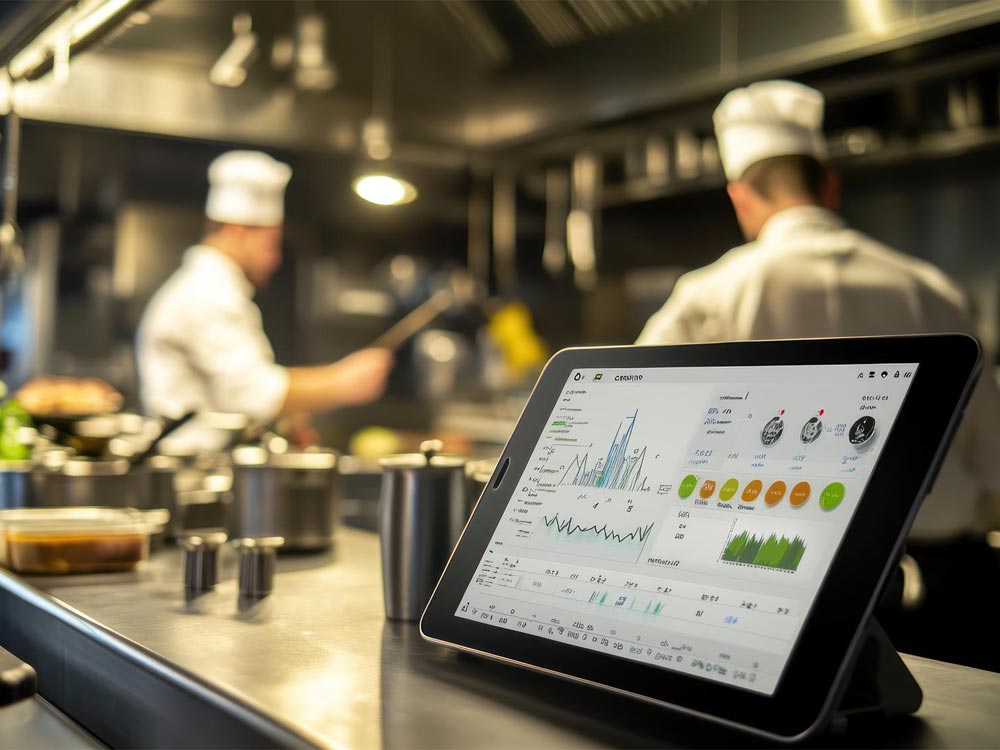Inventory waste management in restaurants can have a huge impact on sustainability, profitability and operational efficiency. Restaurants are now able to optimize their inventory management, predict demand correctly, track perishable goods and reduce waste due spoilage or over-ordering via specialized platform. But the question remains how all such activities are managed?
Here is how software can assist us in achieving this:
(1). Inventory Tracking and Management
Active inventory management software has the ability to monitor real time inventory levels, that provides data about the stock availability, items near expiry and what needs to be ordered. With the help of accurate inventory records, restaurants are able to avoid over-purchasing and make sure the perishable items are used prior to their expiry.
Key Features of Inventory Tracking Software:
- Real-time inventory updates: Automatic ingredients update as per number of dishes sold, real time insights of stock levels.
- Supplier integration: Manual tracking is reduced as software is seamlessly integrated with supplier’s system.
Examples include:
- BlueCart: Offering end-to-end inventory tracking to red uce waste.
- Upserve: Provides predictive analytics to estimate ingredient usage and real time tracking.

(2). Demand Forecasting and Predictive Analytics
Fluctuating demand is often the major cause of inventory waste in restaurants, resulting in underutilization and overstocking of perishable items. Software offering predictive analytics can assess weather patterns, past sales data, seasonal trends and weather patterns to prepare accurate demand forecasting.
Key features of Demand Forecasting:
- Optimized purchasing: Forecasting demand results in more précised ordering, without overstocking.
- Menu optimization: Understanding which dishes have high demand helps in designing the menu which is aligned with customer demands.
- Labor and prep planning: Planning for kitchen labor and preparation is facilitated by forecasting tools to align production with anticipated sales.
Examples include:
- Toast POS: Past sales and customer behavior can be analyzed via this to forecast demand.
- ClearCOGS: An AI -driven platform offering real time demand forecast with major focus on inventory reduction and every day food preparation.

(3). Recipe Management and Portion Control
Inventory waste usually occurs due to varying portion sizes and ineffective recipe management. With the help of inventory management software, restaurants will be equipped to reduce over-preparation, have set standards of portions and effective ingredient use.
Key Features of Recipe Management Software:
- Standardized portion sizes: For all dishes to use same amount of ingredients, resulting in less wastage.
- Cost calculation: Offers accurate cost breakdown for all menu items, helping restaurants to promote profitable dishes and less waste.
- Batch preparation tracking: Each batch preparation is tracked effectively to avoid wastage while cooking.
Examples include:
- KitchenCUT: Caters to recipes and portion control sizes along with inventory tracking.
- ChefTec: Offers costing for portion control, recipes etc., along with inventory management tools to minimize waste and maintain quality in food.

(4). Waste Tracking and Analytics
Certain software solutions are designated for tracking and analyzing food waste in real time, which helps the restaurants in identifying the origin of waste and take appropriate measures.
Key Features of Waste Tracking Tools:
- Waste categorization: Categorizes the waste efficiently and find the root cause of it occurring.
- Waste reduction strategies: Data-driven recommendations are used to adjust portion sizes, revamp the menu if needed and improve storage areas.
Examples includes:
- Leanpath: Tracker for food wastage in the kitchen and guiding restaurants to make adjustments accordingly.
- Winnow Solutions: Utilizes AI to evaluate food waste in real-time, with the help of data on spoilage and over production.
(5). Supplier and Purchase Order Management
There are certain platforms restructuring purchase orders and supplier management, to sort the issue of missed deliveries and over-ordering, two major contributors towards waste. With these tools, restaurants can track supplier performance, order history and pricing to make sure orders are executed in an accurate and timely manner.
Key Features :
- Avoid over-ordering: With the help of real-time forecasting, software prevents over-ordering.
- Bulk vs. fresh orders: Helps in maintaining a balance between non-perishables and fresh ingredients when purchasing them in bulk.
- Supplier management: Chances of better relationship with suppliers by improving order accuracy and avoiding errors or delays.
Examples include:
- MarketMan: Supplier pricing and order can be tracked via this tool, leading to purchasing decisions meeting inventory needs.
- BlueCart: Inventory levels can be matched with the delivery demands and schedules with effective supplier management.
(6). Food Donation and Redistribution
Despite of effective management, restaurants do end up with surplus food, and this is where software solutions come handier in distributing the food surplus to charities and food banks, with an aim to benefit communities.
Key Features of Redistribution Platforms:
- Inventory alerting: Alerts redistribution and local food banks about the food surplus.
- Donation tracking: Donated food is monitored for the purpose of compliance reporting and tax benefits.
- Community engagement: Food donation acts as a contribution towards the community by the restaurants
Example include:
- Food Rescue US: A software connecting restaurants with surplus foods to donate to local charities and food banks.
- Too Good To Go: Surplus food is sold at a lower price to the consumers.
These are some of the software and tools to track ad reduce inventory waste in restaurants. Using these innovations for tracking waste, managing inventory and forecasting demand plays a major role in improving restaurant’s efficiency and building a sustainable business model. These tools provide data-driven decisions facilitated by predictive analytics, optimized inventory control to automate inventory tracking process, waste awareness via tools like Winnow and Leanpath that cater to training needs to reduce losses and much more.
With the help of these technologies, restaurants can achieve low costs, improve operational performance and reduce environmental impact and more of a positive image due to efficient utilization of surplus food via redistribution tools.
.png)








